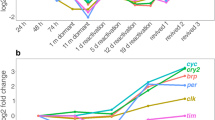Abstract
THE induction and maintenance of larval and pupal diapause are at present thought to be under the direct control of the neuro-endocrine complex associated with the insect brain. Williams1 found that diapausing pupæ of the cecropia moth, Hyalophora cecropia, could be induced to resume development by either a prolonged (6–12 weeks) exposure to a low temperature (4–6 ° C) or by the implantation of the brain of a previously chilled pupa. Unchilled diapause pupal brains were found to be incompetent to induce development when implanted into an unchilled pupa in diapause. The competence or incompetence of a pupal brain appeared to depend on the activity or inactivity of its neurosecretory cells. When active, the neurosecretory cells are responsible for the production of a hormone that is released via the corpora cardiaca and activates the prothoracic glands, which then produce the growth hormone, ecdysone, responsible for the initiation of development2. In the diapause pupa, the neurosecretory activity of the brain is suppressed3, as is its neural impulse activity4.
This is a preview of subscription content, access via your institution
Access options
Subscribe to this journal
Receive 51 print issues and online access
$199.00 per year
only $3.90 per issue
Buy this article
- Purchase on Springer Link
- Instant access to full article PDF
Prices may be subject to local taxes which are calculated during checkout
Similar content being viewed by others
References
Williams, C. M., Biol. Bull., Wood's Hole, 90, 234 (1946).
Williams, C. M., Chemical Basis of Development, 794 (Johns Hopkins Press, 1958).
Williams, C. M., Biol. Bull., Wood's Hole, 110, 201 (1956).
Van der Kloot, W. G., Biol. Bull., Wood's Hole, 109, 276 (1955).
Highnam, K. C., Quart. J. Micro. Sci., 99, 73 (1958).
Fraser, A., Quart. J. Micro. Sci., 100, 377 (1959).
Mitsuhashi, J., and Fukaya, M., Jap. J. App. Entomol. Zool., 4, 127 (1960).
Highnam, K. C., and Lusis, O., Quart. J. Micro. Sci., 103, 73 (1962).
Beck, S. D., Biol. Bull., Wood's Hole, 122, 1 (1962).
Van der Kloot, W. G., Ann. Rev. Entomol., 5, 35 (1960).
Author information
Authors and Affiliations
Rights and permissions
About this article
Cite this article
CLOUTIER, E., BECK, S., McLEOD, D. et al. Neural Transplants and Insect Diapause. Nature 195, 1222–1224 (1962). https://doi.org/10.1038/1951222b0
Issue Date:
DOI: https://doi.org/10.1038/1951222b0
This article is cited by
Comments
By submitting a comment you agree to abide by our Terms and Community Guidelines. If you find something abusive or that does not comply with our terms or guidelines please flag it as inappropriate.



